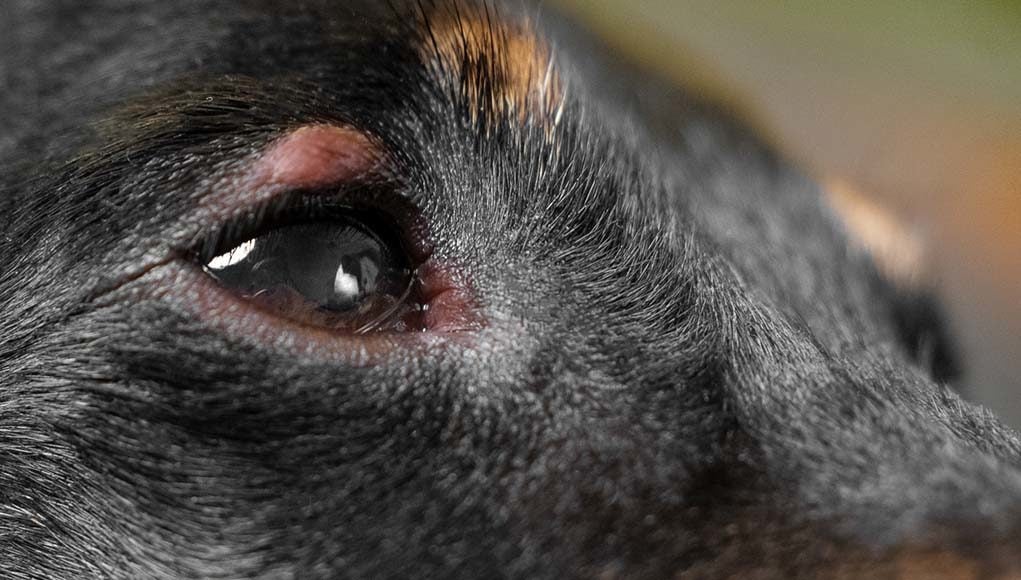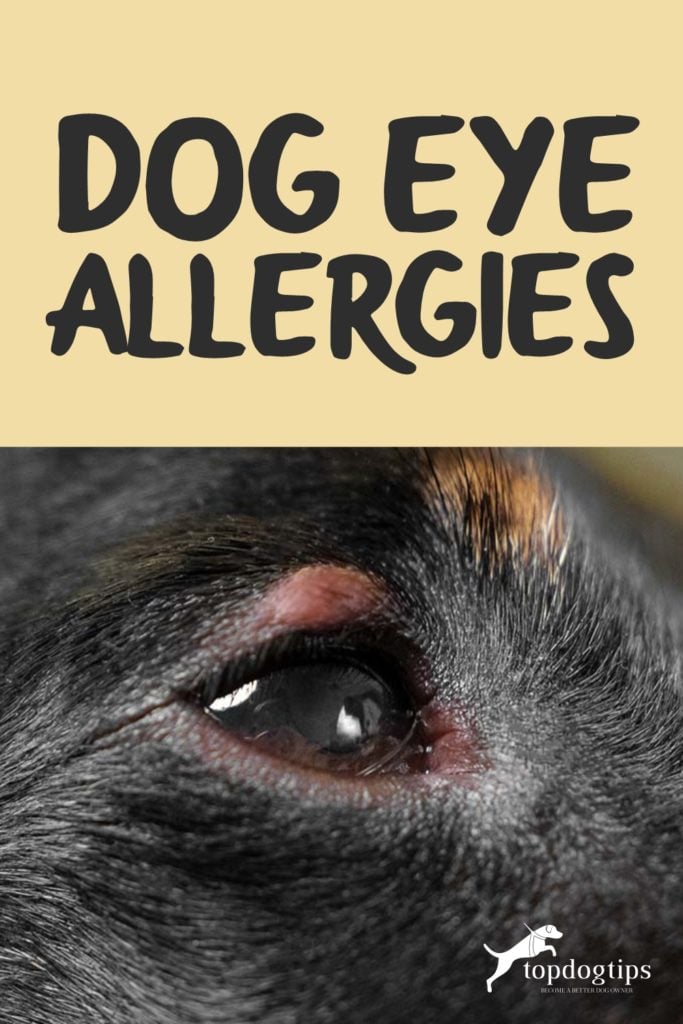Dog eye allergies will make your pet's eyes sore, swollen, and watery. Several causes will trigger such an allergic reaction.
Usually, once the underlying cause is removed, the problem will resolve itself without complications.
Still, sometimes, a trip to the vet is needed for your dog's allergy screen test and a treatment plan.
Eye allergies in dogs cause itchiness and discomfort. You'll notice them because the dog will also have watery eyes, excessive tear production, swollen and red, irritated eyes.
Discharge from a dog's eyes should be clear and watery, but if instead, you see milky or colored discharge coming from the eye(s), this could be a more serious eye problem.
Dog eye allergies are often linked to direct contact with allergens in your home that the animal is sensitive to inhalation of mold, dander, or pollen.
They can also be caused by dog food or certain ingredients. Because there are many possible causes, an allergy screening test is often recommended to diagnose the exact allergen.
Veterinarians will do both skin and blood tests. The results will help you find the best ways to reduce allergen contact in your house.
Some medications (prescription and/or over-the-counter), as well as home remedies, can also help your dog feel better. Below is everything you should know about dog eye allergies and what to do about them.
How to Treat Dog Eye Allergies
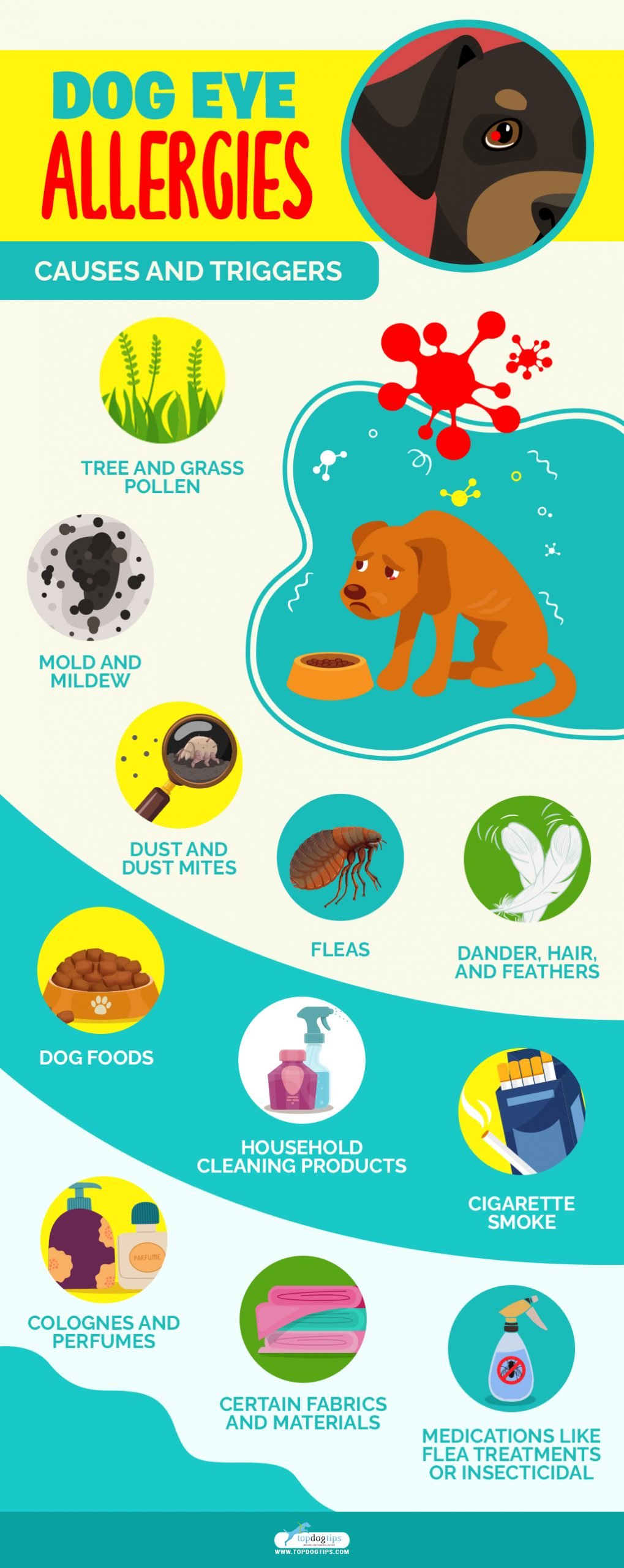
Causes and Triggers of Eye Allergies in Dogs
Like humans, dogs can suddenly develop allergies at any time during their lifetime, even when they previously didn’t have any issues.
Any dog of any age can be susceptible to eye allergies, but they are more common in some breeds, Terriers, Retrievers, Setters, and Brachycephalic breeds.
Some of the most common allergens causing eye allergies in dogs include:
- Tree and grass pollen
- Mold and mildew
- Dust and dust mites
- Fleas
- Dander, hair, and feathers
- Cigarette smoke
- Dog foods or specific ingredients (including meats, grains, soy, etc.)
- Medications like flea treatments or insecticidal shampoos
- Household cleaning products
- Colognes and perfumes
- Certain fabrics and materials
The number of allergens that can cause an allergic reaction in a dog are so wide-ranging and individual to every dog that it's usually difficult to pinpoint the source of the problem by yourself without proper testing.
You can try to narrow it down by keeping a notebook and noting if your dog’s eye allergies get worse after being outdoors, for example. Then you'll know that the cause is something the dog only has contact with outside, like pollen.
However, allergic reactions also are not always immediate, so the best thing you can do for a dog with eye allergies is to get an allergy screening at your local veterinary clinic.
There will be two types of tests done: a skin test and a blood test. Both tests can cost anywhere from $175 to $300, and there may be additional fees for the consultation and sedation. Some vets tack on office fees, too.
Call the vet's office and ask about these and any other additional charges before making the appointment.
Skin Allergy Testing
Results from a skin allergy test for dogs are more reliable than a blood test, according to studies.
A large range of allergens are tested on a dog's skin, and you'll get the results within the same day.
The downside of a skin allergy test is that it requires sedation, shaving of the dog's coat, and a longer stay at the veterinary clinic.
There is also a small risk of bad reactions, and this testing is not suitable for puppies.
Skin tests for dog eye allergies usually work best when performed during a flare-up.
For best results, dogs with allergies should not have been treated with antihistamines or steroids for a few months before the test. Tell your vet if that's not the case.
Some vets offer the intradermal skin test, or you may be referred to a veterinary dermatologist. Your dog will be put under mild sedation, and a small patch of hair on its side will be shaved.
Then tiny amounts of common allergens are injected under the skin’s surface in a grid pattern to keep track of which allergen is which.
After a few hours, the vet will check the patch to see if any injection sites are raised or red. Often, there will be a range of reactions from negative to borderline, to mild and strong positives.
This will tell you which allergens that cause a strong reaction should be avoided. For milder or borderline reactions, the veterinarian will discuss with you what changes in your household or daily routines you can make to prevent future eye allergies in the dog.
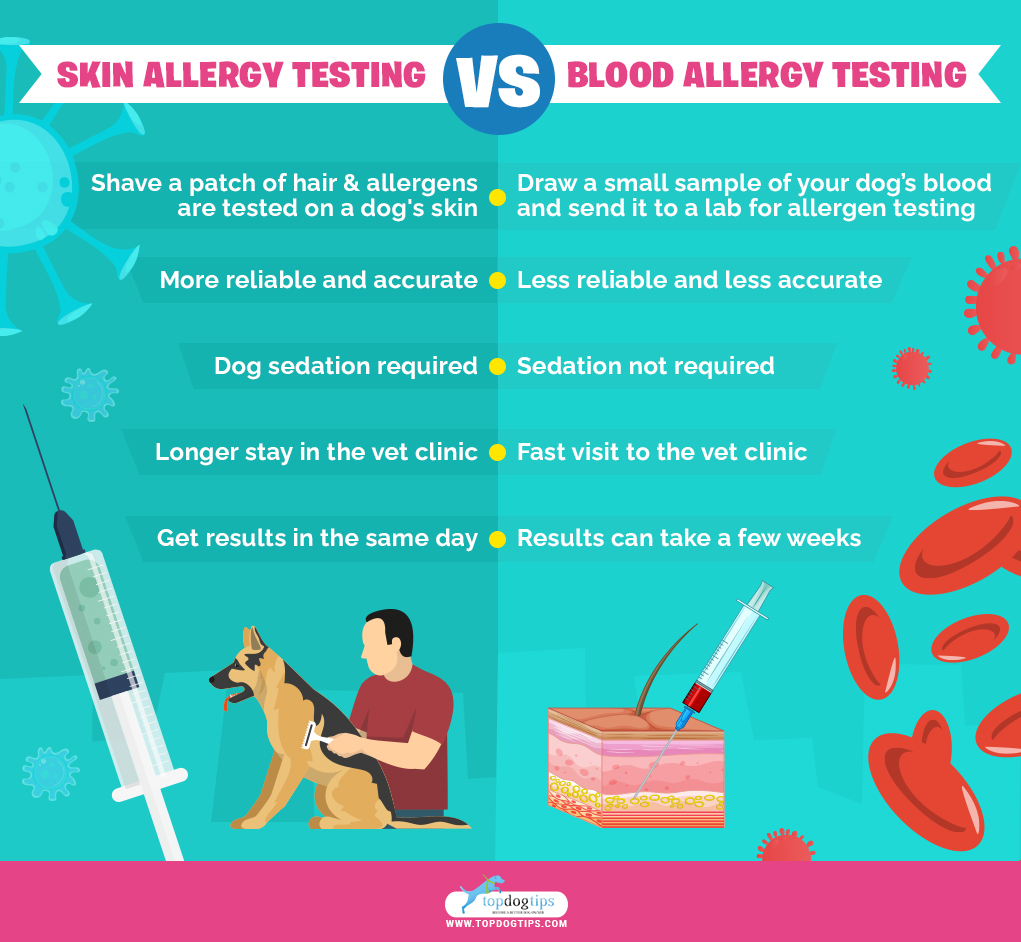
Blood Allergy Testing
A blood test will be performed by drawing a small sample of your dog’s blood and sending it to a lab for allergen testing.
Blood tests are a good option when a skin test is not available if the dog cannot go under sedation or has skin issues already.
While it's less reliable, blood testing does not require sedation, and the vet’s office visit will be over much faster and less stressful for the dog.
Unlike a skin test, because the testing is done in a laboratory, the results can take a few weeks to come back. Blood tests results are also not as accurate as skin test results.

Essential Remedies for Dog Eye Allergies
Remedies for dog eye allergies fall into two categories: lifestyle and medical.
If you already know the exact cause, different preventative measures will also help stop the allergen from affecting your dog's eyes.
Most of the treatment for dog eye allergies will be simply avoiding the allergen and some minor changes at home.
If you have a good idea of what is causing your dog’s eye allergies, take these steps:
- Remove anything in the house that contains the problematic (cause) material.
- If you suspect inhaled allergens such as dust, dander, feathers, or mold, try removing as many sources as possible. Clean your house more often if needed.
- If it’s possible, pull up carpets and take away any soft furnishings that hold onto all these microscopic allergens.
- If it's not possible, then try deep-cleaning all soft furnishings and begin regularly washing your dog's blankets, crates, and beds on high heat.
- You can often work mild allergens around. Using pollen allergy as an example, you can look online for pollen counts each day, take your dog for walks when the counts are lower, or take her to a more urban area.
- In severe cases, it may be necessary to keep your dog in a separate, designated area until you can find a manageable treatment plan.
- An air purifier can also help reduce airborne allergens.
- Gently wipe your dog’s eyes with lukewarm water. Boil the water first and let it cool. This will be soothing for the dog's sore eyes and help remove any allergens or debris from the looks. Use cotton balls and be slow and gentle.
Medication for Dog Eye Allergies
Even after you've made lifestyle changes in your home, you may still need medication for eye allergies in dogs. The most commonly used drugs are antihistamines.
They halt the production of histamines in a dog's body, which are the cause of allergy symptoms like itchy and watery eyes. Consult your vet before giving any medication to the dog.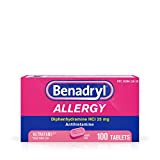
Benadryl Ultratabs Antihistamine Allergy Relief...
Diphenhydramine (Benadryl) is the most popular antihistamine for people, and it's also very effective for dogs with eye allergies. However, it may take anywhere from two days to two weeks to work.
Ensure the brand and type you’re using don’t contain other ingredients like menthol or painkillers like acetaminophen. Standard Benadryl like this one will be acceptable to give to your dog.
Benadryl dose for dogs is 1mg per pound of bodyweight, 3x times daily.
Note that Benadryl is a sedative and may cause drowsiness in the dog.
It can also cause gastric problems and dehydration, so always watch your dog when giving them Benadryl or other medication.
Benadryl should not be used if your dog has certain conditions such as glaucoma, high blood pressure, or cardiovascular disease. It should also not be given to pregnant or nursing dogs.
If not antihistamines, and depending on your dog's eye allergy condition, your vet may also prescribe steroidal eye drops, which will relieve your dog’s eye irritation.
In the case of severe allergies, they may prescribe other eye drops or topical ointments as well.
Some eye allergy supplements can also be given to dogs, such as these things below:
| Preview | Product | Rating | |
|---|---|---|---|

|
Pet Honesty Allergy Itch Relief for Dogs - Dog... | 32,796 Reviews | Check Price |

|
Zesty Paws Allergy & Immune Supplement for Dogs -... | 75,500 Reviews | Check Price |

|
PAWFECTCHEW Allergy Relief for Dogs (150 Immune... | 3,899 Reviews | Check Price |
In Conclusion
Eye allergies in dogs are relatively common, and they are often because of similar environmental allergens that also affect people: dander, pollen, dust, mold, and others.
Other causes of eye allergies could be your dog's food or some specific ingredient in the dog food brand you're using.
Dog eye allergies are not life-threatening, but they will cause itchy and watery eyes and be uncomfortable for the dog. As a result, you need to visit to the vet to perform a skin and blood allergy test.
Once the test is done and cause(s) are known, you can make changes at home to reduce a dog's contact with allergens.
Over-the-counter antihistamines like Benadryl will also help relieve discomfort.
Common Questions about Dog Eye Allergies
Have lingering questions about how to treat dog eye allergies or your pup's allergy symptoms? The following FAQ should help.
How Can I Treat My Dog's Eye Allergies?
Depending on how mild your dog's allergy symptoms are, flushing his eyes may be enough. Just use a sterile saline solution to rinse them a few times each day. Do NOT use a contact solution.
How Can I Soothe My Dog's Itchy Eyes?
If your pup has itchy eyes, you can try giving him Benadryl. This over-the-counter antihistamine is safe for dogs in the correct dose. In other words, it can also help with excessive tearing.
How Do You Know If Your Dog Has Eye Allergies?
The most common symptoms of eye allergies in canines include redness and irritation. In addition, you may also notice your pooch holding his eye closed, squinting or blinking a lot, or rubbing your dog's eye.
Furthermore, frequent eye tearing is also an indication of eye problems.
Your dog's veterinarian will determine if the problem is allergies, inflammation, or something else. From there, he can plan the most effective treatment.
READ NEXT: How to Give a Dog Eye Drops
Disclosure: We may earn affiliate commissions at no cost to you from the links on this page. This did not affect our assessment of products. Read more here and find full disclosure here.


